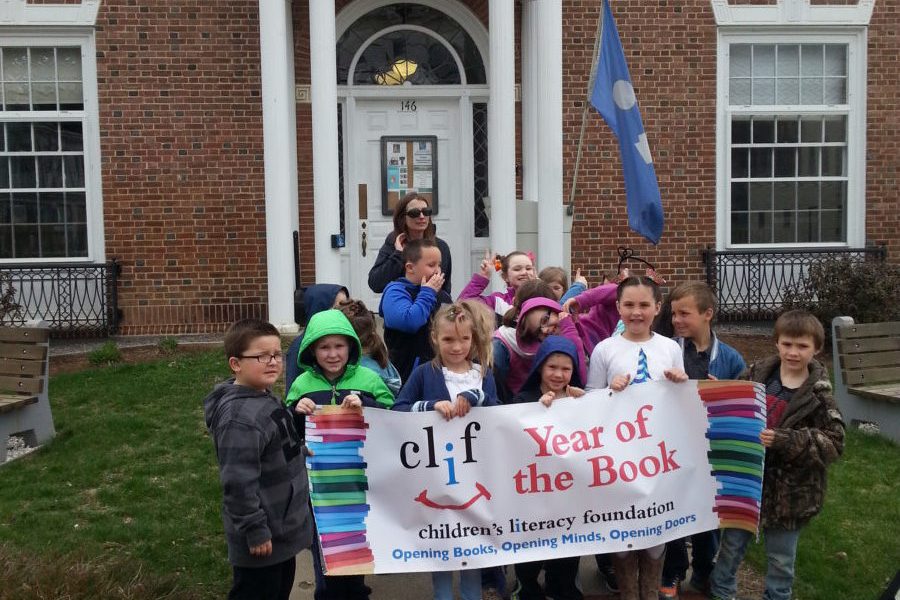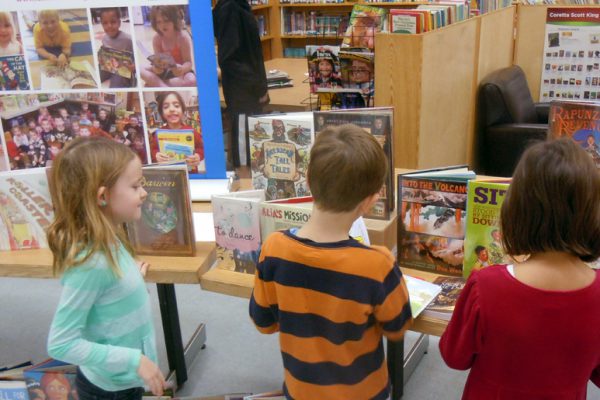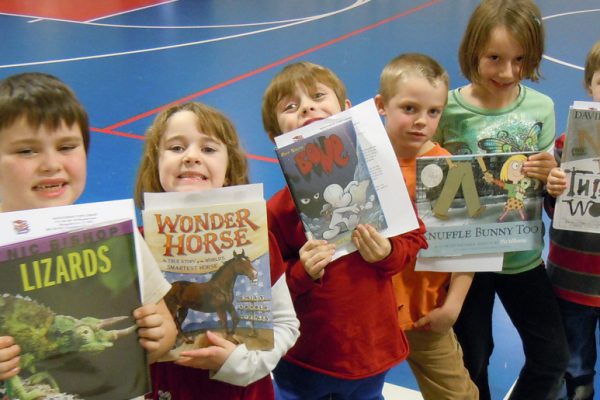
 Question: Why is Marty Kelley, (right) author of the book Ladybug Award nominee Albert’s Amazing Almost Adventure and Almost Everyone Farts, reading The Organic Gardener’s Home Reference to elementary aged children?
Question: Why is Marty Kelley, (right) author of the book Ladybug Award nominee Albert’s Amazing Almost Adventure and Almost Everyone Farts, reading The Organic Gardener’s Home Reference to elementary aged children?
Answer: He read it to train them how to share books with others.
Belmont Elementary School (BES) invited Marty to “train” their K-4th graders to participate in the school’s second year of Reading with Seniors funded through CLiF’s Community Building grant. (NOTE: next deadline for Community Building Grant is October 15!) Last year, because BES received a CLiF Year of the Book grant for 232 PK-1st graders, only the first grade read to seniors. This year, all 470 K-4 students will visit the public library and read with Belmont’s elders.
Belmont, NH, part of the Lakes District, faces a significant challenge with the unemployment rate rising from 3.3% in 2004 to 4.7% in 2014. While town residents continue to value education and support their schools, these statistics show that more residents live on a fixed income, which compromises their ability to support increasing school budgets. In an informal poll of kindergartners, roughly 50 percent of them said that they did not own books and only about 40 percent of the students said they had visited the library. BES applied for a CLiF Year of the Book grant to help build students’ and families’ connections with the school and with Belmont Public Library.
Year of the Book offers $25,000 of literacy activities and supports to schools in the form of author visits, books for classrooms, school and public libraries, 10 books each child choses to keep, and mini grants for teachers. Here are a few examples of how they used the grant components to produce lasting effects on the school and on future students:

Giveaways
After the second giveaway, BES’s amazing librarian/Year of the Book coordinator wrote:
“I think every one of them hugged their books after they made their final choices. The preschool teacher was commenting on how just looking at the pictures and asking us questions was stimulating their speech; apparently, a few of the students rarely talk, but they were joining right in with the others. Seeing them so happy about books never gets old!”
Author Visit
CLiF presenter Marv Klassen-Landis led a session at the CLiF Community Literacy Conference that had teachers as students practicing writing prompts. BES invited him to come do a three-day training for teachers that involved them learning by doing and by observing Marv working with their students.
“When Marv Klaasen-Landis came to work with our students, he decided to have our three-year-old preschool class write a poem together — and then sing it! He told me he hadn’t done the singing part with children this young before, but he decided to see if it would work, and it did. With Marv’s guidance, they wrote a poem called “On a Sunny Day,” and they were indeed able to sing part of it together by the end of Marv’s time with them. Their teacher and I were so impressed with how well they worked together, and how attentive they were to Marv, especially since two of them had only been part of the group for a few days! I know their teacher hopes to incorporate what Marv modeled into her classes next year to help her teach students to work together.”
Classroom Projects
 The first grade has traditionally completed research projects on NH animals. This year, a mini grant provided new books from which they could conduct their research. They then wrote a “teaching” book about their animal, created acrostic poems, and made dioramas depicted their NH animal in two different seasons. The teacher wrote:
The first grade has traditionally completed research projects on NH animals. This year, a mini grant provided new books from which they could conduct their research. They then wrote a “teaching” book about their animal, created acrostic poems, and made dioramas depicted their NH animal in two different seasons. The teacher wrote:
“One cool comment from a student during cleanup time was, “I don’t want to stop researching the humpback whale. This is so much fun!” But she also shared the impact it had on the teachers:
“The first grade teachers have learned a lot about how to teach research. From citing sources to teaching how to find important information, to writing the information in their own words. We plan to continue with this same project next year!”
The librarian even helped extend the project by making riddle wheels with the kids. She wrote: “With books that they could read on their own, the students enjoyed this unit more than they ever have and were able to demonstrate their knowledge in new and exciting ways, in addition to the reports that they usually write. As an added bonus, the first grade team and I collaborated in different ways and have plans to extend that collaboration even further next year.”
Classroom Libraries
Year of the Book provides $3,500 for teachers to order new books for their classrooms. The research proving that kids read more when they chose what they want to read extends to adults, too. Teachers were motivated by adding books of their own choice to their classroom libraries.
“Our teachers have always read to students, but I saw the new books sparking their creativity in new ways. For instance, our preschool teacher would read the books, then engage the students in activities that extended their connections to the books. After they enjoyed several of the Mo Willems’ Pigeon books, the teacher gave each student a large drawing of the pigeon and had them add a drawing what they thought the pigeon shouldn’t do. The results were creative, informative, and funny!”
What happens this year?

Every Year of the Book school now receives $1,000 in funds to help keep the momentum going. BES plans to organize one literacy activity each month from CLiF’s list of activities. Additionally, they propose to use CLiF funding to purchase a variety of math-related books from FirstBook. Students at each grade level would then create their own similar books, based on the math they are studying at that grade level. They would also like to use CLiF funds to hold a Bingo for Books night in conjunction with their PTO. The hope is that this event would become a regular PTO event in future years, with each student who attends leaving with a book in hand. Finally, the school proposes investing in a school-wide One Book, One School program. Students would then meet in multi-age groups to discuss the book, make connections across grade levels, and participate in related activities.
Meanwhile, the Belmont Public Library and BES continue to strengthen their relationship and change the initial statistic that 40% of kids have visited the public library. By the end of this year’s Reading with Seniors project, 100% of kids will have visited!
“The students have loved every part of their library field trip – walking to the library, hearing about everything the library has to offer, and reading to their buddies. They’re so proud to show off their emerging reading skills, and the seniors have been fantastic with them. When I ask who thinks they’d like to come back to the library, every hand goes up.”
CLIF is extremely grateful for:
- Coordinators – In Belmont: “An extremely energetic coordinator is our school librarian, Kristin Desborough. She will lead the charge with passion, exuberance and the guiding principle that active, engaged readers can move mountains.”
- Teachers – In Belmont: “In 18 years working in education, I have never worked with a more dedicated staff of teachers. They are consistently trying to find ways to encourage excitement about learning and ways to involve families in the process. I truly believe that being awarded this grant would further their efforts and create a much-needed bond between our school and our families.”
- Presenters – In Belmont: “Each presenter brought his or her own unique writing experiences and style to life, giving our students a multifaceted idea of what it means to be a writer and share stories with others. Students continued to talk about the visits long after they occurred, and several came to me to share stories they were inspired to write after seeing an author in person.”




Great blog. So much much info! Love it.
Thanks, Simon! 🙂